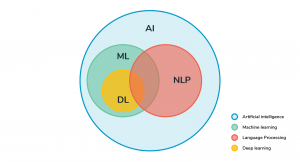
How Smart Retailers Use Artificial Intelligence
AI (Artificial Intelligence) is a term that’s become ubiquitous in the retail industry. To some, it is futuristic. To others, it is a meaningless buzzword. The better you understand it, the better you will be at gauging brands who are using it to solve real problems from those who are throwing the word around.
In retail, AI relates to everything from interacting with customers via chatbots and making purchasing recommendations to steering marketing and more. If utilized correctly, AI can be a critical factor in a company’s ability to acquire, retain, and engage customers more efficiently. But before you can use it well, you need to know how it works.
Defining Artificial Intelligence
Forbes writer Bernard Marr defines AI as “the broader concept of machines carrying out tasks in a way that we would consider ‘smart’.” In short, it is an umbrella term for any computerized function “mimicking human decision-making processes.” Now, while some may use machine learning and AI interchangeably, they are not mutually exclusive. Machine learning (the ability for machines to learn for themselves), NLP (the ability for computers to understand variances in human language), and deep learning (essentially a more in-depth way of carrying out tasks via machine learning) all fit under the AI umbrella.

A quick note: As the above picture illustrates, not all machine learning (ML) is considered artificial intelligence. Not all natural language processing (NLP) is considered ML. While there can be overlap, it’s important to understand the basics of the more popular applications so you can separate the hype from how things actually work.
Understanding Machine Learning
Let’s focus on machine learning for a bit. There are three types: supervised, unsupervised, and reinforcement. Understanding these three categories may help identify how brands are actually putting them to use.
- Supervised Learning: In supervised learning, you give the machine a specific detail or “output.” And, with enough data on that specific detail, the machine will train itself to find other things that are similar. In retail, visual search is a great example of this category. When you upload a photo of a blue collared shirt to Google, you receive a ton of visually similar blue collared shirts. Why? Because an algorithm has been trained to identify and replicate results for your original “output.”
- Unsupervised Learning: Unsupervised learning provides results based on patterns the machine sees in large clusters of data — not specific details. Amazon’s shopping recommendations illustrate how this works. Amazon collects data on the customer journey and what people consider when they shop. From that information, machine learning is used to provide others who are shopping for similar things with recommendations. Each interaction strengthens connections about what types of items are bought together (blue shirts and watches) or if people with similar backgrounds behave similarly while shopping (are fathers more likely to consider blue shirts), etc.
- Reinforcement Learning: Reinforcement learning is when a machine improves how something works through positive or negative feedback. This type of ML is most prevalent in the technology marketers use to run campaigns. But what do the positive feedback algorithms need to improve look like? Well, it could be a customer clicking an ad or making a purchase. From these positive actions, ML algorithms can begin to recognize patterns in what leads customers to make these positive decisions or even the type of customers more likely to purchase.
AI Best Practices & Brand Use Cases
On the consumer-facing end, AI makes it faster, easier, and more personable for customers to find and purchase products online. Artificial Intelligence is also changing consumer interactions in physical stores. As Storefront Magazine states, “it’s projected that 83% of goods purchased globally in 2022 will still be bought in-store” and customers want to have an in-store experience that matches or exceeds online shopping. Below are three short, concrete use cases in how AI can be used to modify and improve retail business practices.
eBay
eBay’s VP and chief architect of AI, Sanjeev Katariya, states that AI “is woven into all aspects of the eBay marketplace, anticipating the needs and wants of buyers and sellers, inspiring shoppers on the hunt for something special, empowering entrepreneurs looking to grow their business, and making the platform more accessible to everyone.”
Recently, eBay launched a visual search platform which “which lets users find items by snapping photos of real-world objects, and find it on eBay, which surfaces listings of products similar to those on virtually any webpage.” If a potential customer sees someone with a pair of shoes they like, they can take a picture and eBay will not only find the shoe brand, but it may also make suggestions for socks or a matching top. This makes things simple and convenient for the buyer and gives the retailer additional selling opportunities.
Farfetch
Luxury fashion vendor Farfetch, for example, has outfitted their fitting rooms with smart mirrors, which gives shoppers the ability to request different sizes, colors, or items. “The customer’s information and shopping habits are then stored in Farfetch’s database so that the company can later access information about that customer’s personal style, previous purchases, and browsing history.” This not only benefits the customer in the immediate sense but also helps Farfetch’s business.
As Petah Marian, senior editor of retail intelligence at WGSN explains, “Understanding which products are being tried on and not bought, what’s being sized up or down, or being styled together, is the physical equivalent to knowing what was put into an online shopper’s cart and not bought.” Collecting this valuable data would have been previously unheard of before this AI integration, which can be used to better build customer profiles, and drive marketing campaigns. Especially if this data is integrated with a customer’s online data. This integration can be achieved with data orchestration tools.
Freshly
At Freshly, AI is helping with customer service. Already, 80% of brands have implemented or plan to implement chatbots. One company that prides itself on its AI-supplemented customer service is meal delivery service, Freshly. Freshly uses Cx Moments, an NLP and machine learning program that “analyzes text from tickets and live chat sessions.” As Freshly’s VP of Customer Experience, Colin Crowley explains, “Cx MOMENTS provides the team with a detailed view of all of the interactions Freshly has with its customers, while removing the noise found in tickets overhead.”
This functionality not only creates faster response times and more satisfactory customer engagements, but “provides information to the web development and marketing departments… and a better understanding of customers’ sign-up issues based on real customer feedback — all without cumbersome, manual tagging by customer service agents.” Essentially, Freshly is finding ways to ameliorate customer concerns while making AI-assisted adjustments so that future customer engagements work seamlessly.
How Lineate Can Help
AI helps with everything from facial recognition software that detects customer mood to predictive restocking. And the more data you collect, the better your results will be. With 250 developers across different languages and specialties, Lineate can simplify your most complex customer problems with custom machine learning algorithms. Want to see how? Book some time with our SA team to learn the details.
Share:
Got a project?
Harness the power of your data with the help of our tailored data-centric expertise.
Contact us